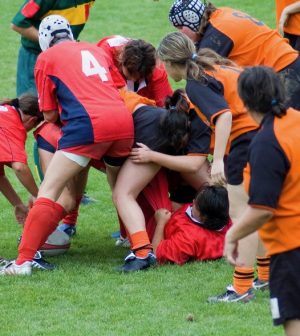- Understanding the Connection Between Anxiety and Depression
- How Daily Prunes Can Influence Cholesterol and Inflammation
- When to Take B12 for Better Absorption and Energy
- Epsom Salts: Health Benefits and Uses
- See What Saffron Can Do for Sleep and Heart Health
- 6 Common Mistakes to Avoid Before Your Physical
- Can Sweating Really Help You Beat a Cold?
- Strengthening Your Relationship: Practical Strategies
- Skip Storing This Everyday Product in the Fridge Door
- Green Tea + B3 Pairing May Boost Brain Health
Sports Concussion Recovery Time Similar for Men, Women

It’s long been thought that it takes more time for a woman to recover from a concussion than a man.
But a new national study of U.S. college athletes refutes that notion, finding that women and men recover from sports-related head injuries at about the same pace.
Recovery patterns for both genders were similar on tests of brain function, concussion symptoms, mental health, and balance and reaction time, according to a report published recently in the journal Sports Medicine.
There also was no significant difference in the time it took men and women to return to unrestricted participation in sports, researchers found.
“I think a lot of people will be surprised in such a large sample that women and men recover along the same trajectory,” said senior researcher Jaclyn Caccese, an assistant professor with the Ohio State University School of Health and Rehabilitation Sciences. “For many years, we’ve thought women took longer to recover, but evidence suggests that if women get the same access to care, they do recover similarly.”
For the study, researchers analyzed medical data from more than 900 athletes competing in sports at NCAA colleges. About three in five athletes in the study were female.
The analysis focused on 15 sex-comparable sports that included basketball, diving, ice hockey, soccer and volleyball. The research team specifically excluded all-male sports like football and wrestling, as well as all-female sports like field hockey.
“Much of the concussion research came out of football, a predominantly male sport,” Caccesse said. “This study is important because it’s the largest study of concussion recovery in women to date.”
For example, a 2022 review showed 40% of 171 studies upon which athlete concussion recovery consensus papers are based had no female participants, Caccesse noted. Overall, the studies relied on samples that were 80% male.
“We’ve been making clinical decisions based on studies that included only a very small percentage of females,” Caccesse said. “But if student-athletes’ cognitive function, symptoms and mental health are recovering along the same trajectories, we probably don’t need to hold women back longer.”
Participants completed pre-season health assessments to allow researchers to accurately track recovery from any concussions that might occur.
Post-concussion evaluations were taken within six hours of the head injury, one to two days later, the day they started their return-to-play protocol, the day they were cleared for competition, and six months post-injury.
Tests included assessments of brain function, memory, balance and reaction time, as well as surveys on health, anxiety, depression and quality of life.
Recovery trajectories did not differ by gender, except that women reported more problems with eye and inner ear function than men within 48 hours of their injury.
Women on the whole waited a day longer than men to start return-to-play workouts, but both genders returned to unrestricted competition after the same amount of time — on average, two weeks post-concussion.
Women did report more symptoms than men, both at baseline and during recovery. These included more complaints of headache, pressure in the head and fatigue, researchers said.
This suggests that gender-specific norms need to be established, to allow doctors to properly evaluate an athlete’s health following a concussion, Caccesse said.
“Otherwise, clinical providers might think women are not recovered who actually are,” Caccesse said in a university news release.
High schools tend to focus athletic trainer resources on sports with the highest risk of injury, mainly male-dominated football, Caccesse said. That means there’s a good chance female athletes in high school haven’t received the same sort of medical attention.
“Student-athletes at the institutions in this study receive immediate access to the best sports medicine evaluation and treatment. I think that could be one of the driving factors in why we didn’t see much of a sex difference,” Caccese said.
“Historically, some women’s sports didn’t have the same on-site access to health care, and what that does is result in delayed evaluation, delayed initiation of treatment and prolonged recovery,” she explained. “I think having someone on the field watching and taking care of athletes and knowing them and knowing how to provide concussion management is key.”
More information
The U.S. Centers for Disease Control and Prevention has more about protocols for returning to play following a concussion.
SOURCE: Ohio State University, news release, Jan. 23, 2024
Source: HealthDay
Copyright © 2026 HealthDay. All rights reserved.










